HISTORY - Social Policy in the Post-Soviet States (South Caucasus)
General Aspects of Social Policy
In my last article I addressed some of the major historical elements of Post Soviet developments. I would like to explore some of the social internal changes. The social policy of post-Soviet countries includes policies and administration of social services in education, health care, housing, income maintenance, etc. (see Spicker: An introduction to Social Policy)
At the same time, social policy is a sphere of political bargaining and discussions. Similar to tax policy, social policy can be inclusive or exclusive – meaning that social policy may aim to provide public health, education, employment services to society and all groups in society, or it may differentiate various groups for various services. Social service provision requires funding to be included in the state budgets. Social service provision is about redistributing a common wealth among society and is thus tightly interconnected with the tax system and economic soundness of a country. That is, if a country has to finance certain services, first and foremost it has to collect financial resources (i.e. taxes).
Video which addresses Social Policy:
Soviet Social Services
Soviet officials prided themselves in regards to a high life expectancy and the annual growth of the Soviet population. However, infant mortality and adult mortality seemed to have increased in the 1970s. The USSR government was not explaining the reasons and had even stopped publishing statistics on child mortality, but some researchers speculated that those developments were caused by poor health conditions and services (Ryabushkin 1978).
Education was free in Soviet times. One of the goals of the USSR was to eradicate illiteracy, and in fact, by the 1960s nearly all children in the USSR had access to education. Education was seen as the way of contributing to the Soviet State by its citizens and the way through which people would become dedicated to the system. The access to primary, secondary, and technical education was free and easier for Soviet citizens to enter than institutions of higher education – often only 20% of university applicants cleared the entrance examinations. Free and universal access to healthcare to the citizens of Soviet Union was guaranteed by the Soviet Constitution. Similar to the education sector, health care was also state regulated and was headed by the Ministry of Health of USSR. However, protectionism and embezzlement were also entrenched in the health care system where billions of Soviet rubles were wasted.
Social Policy in South Caucasus
The Human Development Report 2010 that compares health, education and income in 169 countries reveal the social hardships present in the region. Among the 169 countries the HDI rank of Azerbaijan was 67, for Georgia – 74, and for Armenia – 76.
Poverty and IDP’s
The Social conditions brought about by the collapse of the Soviet Regime were dire in all post-Soviet republics. Regardless of the economic reform model chosen by those states (be it gradualism or a shock therapy) economic hardships led to loss of jobs, increase of poverty, and state budget deficits (Dudwick et. al 2003). Consequently health and education sector funding was reduced resulting in a deterioration of those sectors. In this regard, the 3 states of the South Caucasus were not an exception.
Besides IDPs, the overall poverty level in post-Soviet South Caucasus has increased. According to the official data almost half of the populations in all three countries live in poverty (Cornell 2002:36-37). Yet official data from Azerbaijan, for instance, insisted that only 29% of its population lived in poverty among which 72.5% were IDPs (see Video: Oil wealth 'kept from Azerbaijan's poor' - 26 Jan 08).
Yet, it is worth noting that poverty has been reduced in all three countries with the help of international organizations. One example being the “Poverty Reduction and Growth Facility” initiated by the “International Monetary Fund” that aims to make poverty reduction and growth the cornerstone of its lending to low-income countries (see: IMF Factsheet).
Moreover, the situation was further worsened due to the refugees and Internally Displaced People (IDPs) from Kharabakh in Azerbaijan and Abkhazia and South Ossetia in Georgia. The overall living conditions, lack of proper education, sanitary, health conditions and opportunities for employment have been common hardships for the IDPs in the region. UNCHR has been one among other international organizations providing aid to Georgia and Azerbaijan to assist in dealing with IDP’s (Cornell Caspian Consulting 2002: 35).
Employment
The employment level in post-Soviet states, and particularly in the South Caucasus, has remained low since the Soviet collapse. While some of the problems are blamed on the close down and deterioration of production sector in most of the countries, a lack of investments and the absence of new job-creation have contributed to the low level of employment. For instance, the high rate of unemployment in Azerbaijan contributed to the increased level of poverty. Official statistics seem to underestimate the real unemployment rate in the country, and the labor market of Azerbaijan seems to have both hidden unemployment and hidden employment as well (i.e. employment without contracts). The table below provides official statistics and demonstrates the tendency of increased unemployment in both the male and female population of Azerbaijan during a ten-year time period. However, some analysts state that those numbers underestimate the reality.
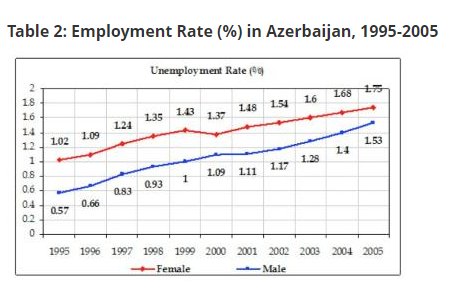
Georgia and Armenia as well have had low employment rates. From the data of 2005 on Armenia it seems that 1 203.3 thousand persons were unemployed out of which 1105.3 (91.9%) were engaged in some kind of economic activities, while 98.0 thousand (8.1%) were without any job (see ICHD report). As for Georgia, the unemployment rates went up from 212.2 thousand unemployed in 2000 up to 279.3 thousand unemployed in 2005, which in percentage was 10.3% and 13.8% respectively. The table 3 below demonstrate this tendency.
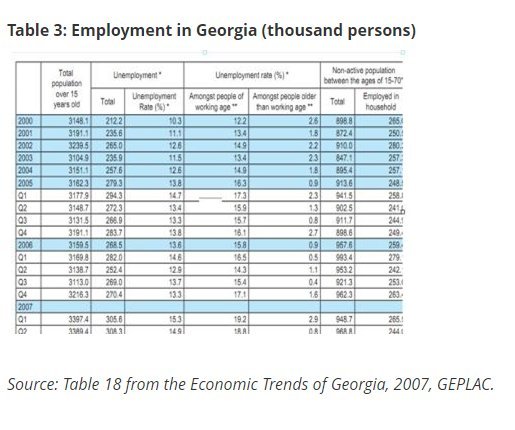
Health Care
The health care systems have suffered in post-Soviet South Caucasus mainly due to the lack of state funding. The market economy brought changes in the health sector where private health insurance companies, private hospitals, and pharmaceutical companies emerged. Still in Azerbaijan the health sector is state-subsidized but the funding that the budget provides is only one third what is needed in the country. In 2007 around 62% of the health expenditure came from the general government funds that also includes the money from the State Oil Fund. Table 4 below shows the actual decrease in the total health expenditure as percentage to GDP in Azerbaijan over the last seven years.
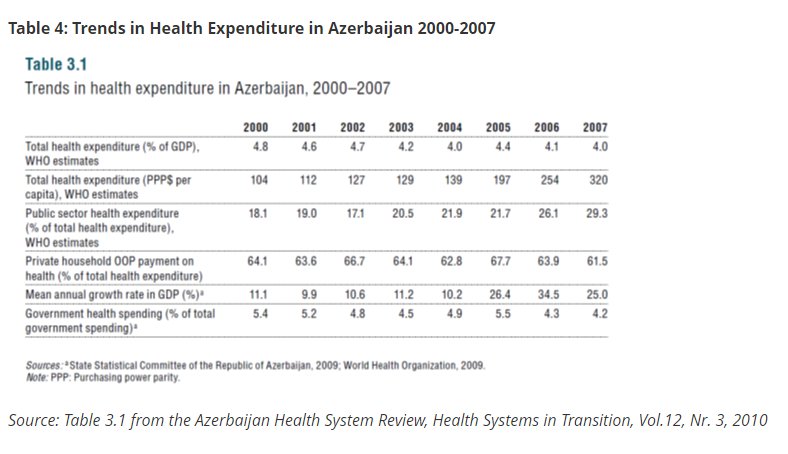
As for Armenia, while in 1998 the health expenditures from the state budget amounted to only 8% to GDP it has since increased. Compared to its neighbors in the region Armenia seems to have a larger share of health expenditure from public resources, but 50% of the total resources in 2006 were still financed from the out-of-pocket resources in the country.
Table 5 below provides an illustration of the government health expenditure over the period of 2001-2008 as a percentage to GDP. It seems that the lowest indicator in expenditure from the public resources in Armenian health care was in 2006 and 2007, while in 2008 it reached 23% to GDP close to the level it had in 2001 (23,6% to GDP).
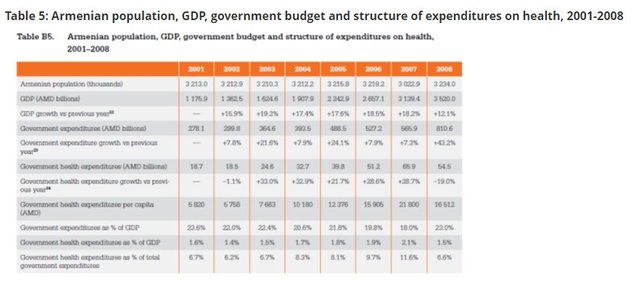
Source: Table B5 from the Armenia: Health System Performance Assessment, 2009, World Health Organization.
In Georgia though the health care system funding is mainly coming from the out-of-pocket payments thus limiting the access to the individuals able to pay (see report).
Table 6 below provides data on the trends in public expenditure in health sector in Georgia as the percentage of GDP during the years of 2003-2007.
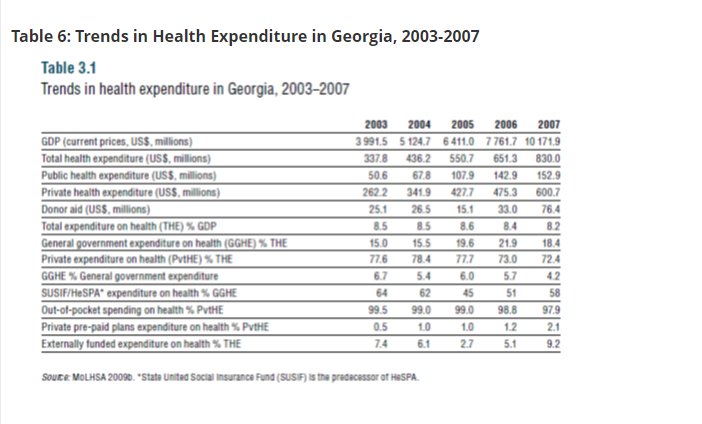
Source: Table 3.1 from the Georgia Health System Review, Health Systems in Transition, Vol.11, Nr. 8, 2009.
As the numbers reveal it seems that public funding in Georgian health systems has remained low and somewhat constant over time ranging from 8.2% to 8.6% of GDP. However, when comparing all three South Caucasian states in terms of expenditure in the health sector, Azerbaijan ranks lowest spending approximately 4% of its GDP annually in 2007, while Georgia spent 8.2% of its GDP in the same year, and Armenia spent 18% of its GDP.
When it comes to Russia and the South Caucasus region "nothing compares to you". Once again wonderful analysis supported with proper data. I am a big fan of yours.
Thanks again. I appreciate the vote of confidence. I will continue to write on this very interesting part of history as well as some other diverse topics which I am currently studying.
thorough piece, deserves more recognition